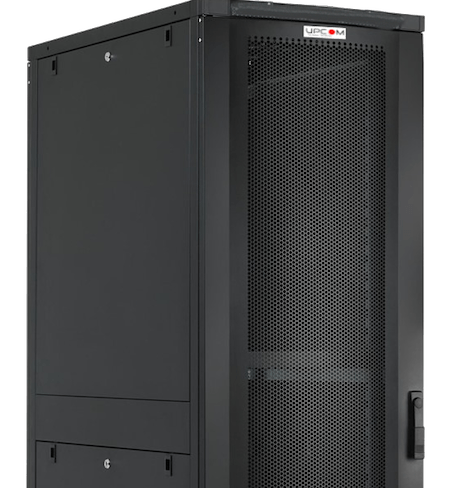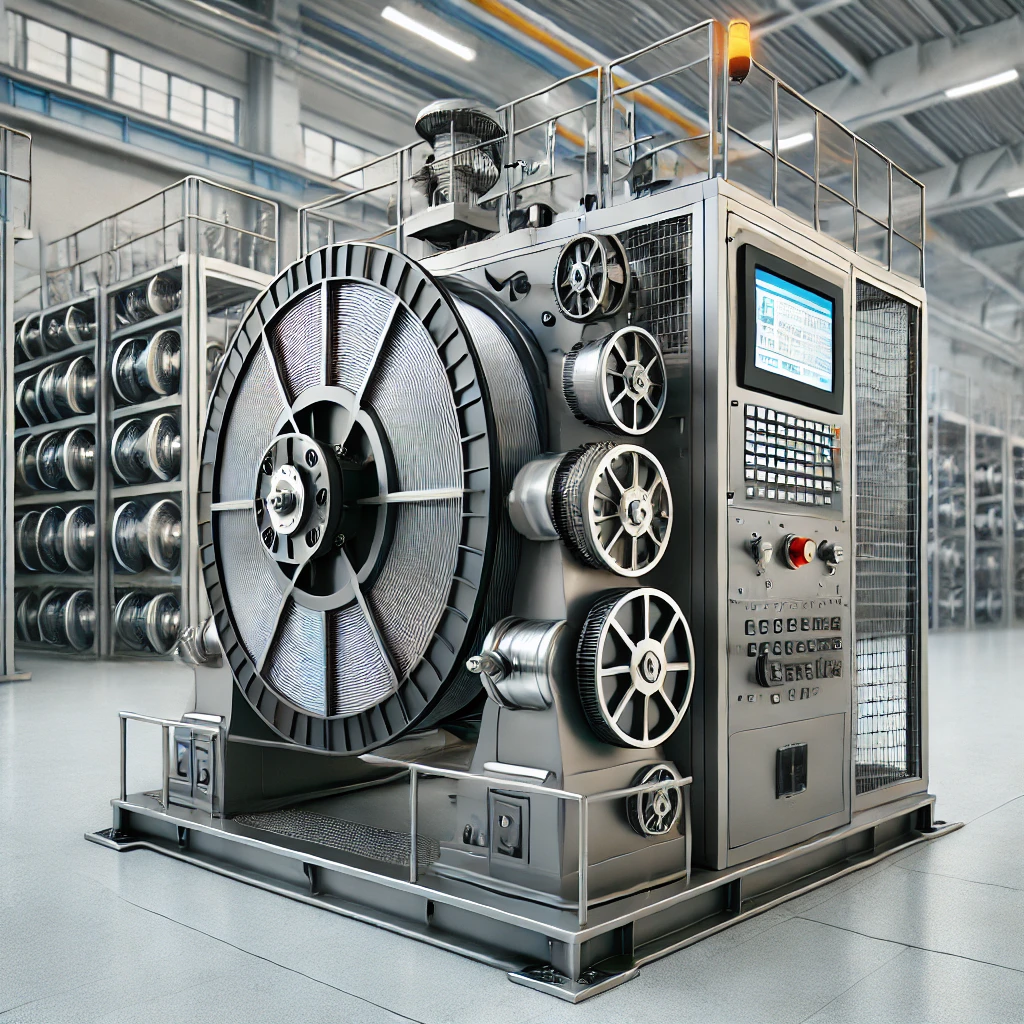26 Dec 19″ Rack Cabinet
What is a 19” Free Standing Rack Cabinet?
19” free standing rack cabinets provide a robust, cost-effective enclosure solution. PDU mounting or connectivity on both the front and rear of the cabinet. The Free Standing 19” Rack cabinets are ideal for high-density data center environments, enabling increased cabling and equipment density while providing excellent accessibility and thermal efficiency. All of these features are integrated into a full-featured modular enclosure that is equally effective as a standalone network and server cabinet.
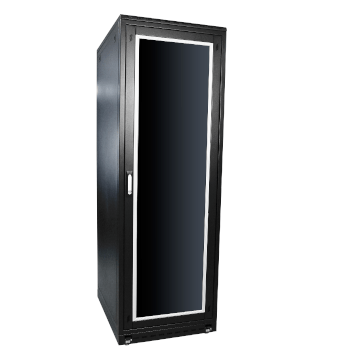
FS-Line
Why are racks 19 inches?
The 19-inch standard for racks was first established in the early days of telecommunications and data networking. The 19-inch dimension refers to the width of the rack measured between the inside of the mounting flanges. The width of 19 inches was chosen because it was a common size used in the manufacturing of electronic equipment at the time, and it allowed for the easy installation of equipment into the racks.
The standardization of the 19-inch rack allowed for the development of interchangeable equipment and ensured that different manufacturers could create equipment that would fit into the same rack. This standardization also made it easier to manage and organize equipment in data centers, server rooms, and other networking environments.
The 19-inch rack standard is supported by several industry organizations and is widely used in the telecommunications and data networking industry. It’s now considered an international standard, and equipment from different manufacturers can be easily integrated into the same rack, regardless of their origin.
In summary, the 19-inch standard for racks was first established in the early days of telecommunications and data networking, because it was a common size used in the manufacturing of electronic equipment at the time, and it allowed for the easy installation of equipment into the racks. The standardization of the 19-inch rack allowed for the development of interchangeable equipment, and it’s now considered an international standard.
How tall is a 19U rack?
A 19U rack is 19 rack units tall. In the standard measurement system for racks, each rack unit (U) is 1.75 inches (44.45mm) in height. Therefore, a 19U rack is 19 x 1.75 inches = 33.25 inches (845.45mm) tall.
It’s worth noting that the 19U is just one of the many sizes racks can come in, but it’s a common size for small to medium-sized data centers, server rooms, and other networking environments. It’s also common to find racks that are 42U tall, the most common size in data centers, this way they can accommodate most of the equipment.
In summary, a 19U rack is 33.25 inches (845.45mm) tall, and it’s a common size for small to medium-sized data centers, server rooms, and other networking environments.
What size is a 19-inch rack?
A 19-inch rack is a standardized frame or enclosure used to mount multiple equipment units such as servers, switches, routers, and other networking devices. The 19 inches refers to the width of the rack measured between the inside of the mounting flanges. The standard height for a 19-inch rack is 42U (42 rack units) which is equal to 73.5 inches (1870mm) in height. Each 1U is equal to 1.75 inches (44.45 mm) in height.The standard size of a 19-inch rack is designed to accommodate most equipment and allows for easy installation and maintenance of the devices. The 19-inch rack standard is widely used in data centers, server rooms, and other networking environments to organize and manage equipment.It’s worth noting that there are other rack sizes as well, like a 21-inch rack and a 23-inch rack, but the 19-inch rack is the most widely used and considered a standard size. In summary, a 19-inch rack is a standardized frame or enclosure that is 19 inches wide, and 42U (73.5 inches) high, used to mount multiple equipment units such as servers, switches, routers, and other networking devices.
What does 20U rack mean?
A 20U rack is 20 rack units tall. In the standard measurement system for racks, each rack unit (U) is 1.75 inches (44.45mm) in height. Therefore, a 20U rack is 20 x 1.75 inches = 35 inches (889mm) tall.
It’s worth noting that the 20U rack is not a very common size, but it’s considered a standard size that can be found in some data centers, server rooms, and other networking environments. It’s also common to find racks that are 42U tall, the most common size in data centers, this way they can accommodate most of the equipment.
In summary, a 20U rack is 35 inches (889mm) tall, it’s not a very common size, but it’s considered a standard size that can be found in some data centers, server rooms, and other networking environments.
How do you measure 19 racks?
Measuring a 19-inch rack typically involves measuring the width, height, and depth of the rack.
- Width: The width of a 19-inch rack is standardized as 19 inches, which is measured between the inside of the mounting flanges. This measurement is important for ensuring that equipment will fit properly in the rack.
- Height: The height of a 19-inch rack is measured in rack units (U) and is typically 42U, which is equal to 73.5 inches (1870mm) in height. Each 1U is equal to 1.75 inches (44.45 mm) in height.
- Depth: The depth of a 19-inch rack is measured from the front to the back of the rack. This measurement is important for ensuring that equipment will fit properly in the rack and to ensure enough room for cable management.
It’s worth noting that these measurements may vary depending on the specific rack, as some racks can have different depths, widths or heights.
In summary, measuring a 19-inch rack typically involves measuring the width, height, and depth of the rack. Width is standardized as 19 inches, height is measured in rack units (U) and is typically 42U, and depth is measured from the front to the back of the rack. These measurements are important for ensuring that equipment will fit properly in the rack, and to ensure enough room for cable management.
How do you determine rack size?
Determining the size of a rack typically involves measuring the width, height, and depth of the rack.
- Width: The width of a rack is measured between the inside of the mounting flanges. This measurement is important for ensuring that equipment will fit properly in the rack, and for determining the rack’s standard size, which is usually 19 inches for most racks.
- Height: The height of a rack is measured in rack units (U) and is typically 42U, which is equal to 73.5 inches (1870mm) in height. Each 1U is equal to 1.75 inches (44.45 mm) in height. This measurement is important for determining the amount of equipment that can fit in the rack.
- Depth: The depth of a rack is measured from the front to the back of the rack. This measurement is important for ensuring that equipment will fit properly in the rack and to ensure enough room for cable management.
It’s also worth considering the weight capacity of the rack, especially if you are planning to install heavy equipment on it.
In summary, determining the size of a rack typically involves measuring the width, height, and depth of the rack, and the weight capacity of it, to ensure that the equipment will fit properly in the rack and to ensure enough room for cable management. The width of the rack is usually 19 inches and the height is measured in rack units, and it’s typically 42U.
What is the size of 1u rack?
For networking equipment racks, the term 1U is used to determine one rack unit of height. To be more clear, 1U equals 1.75-inches (44.45mm) of rack height. Therefore, a 2U rack mount height would be 2 x 1.75”, which equals 3.5-inches high.
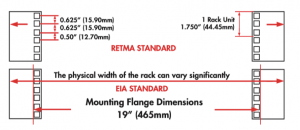
What does U mean in rack space?
U is the standard unit of measure for designating the vertical usable space, or height of racks (metal frame designed to hold hardware devices) and cabinets (enclosures with one or more doors). This unit of measurement refers to the space between shelves on a rack. 1U is equal to 1.75 inches.
Single and Double or 4-Fan modules are available. Digital Thermostat is available at fan modules. Maybe compatible with all model and brands of cabinets. They are usually plug and play with on/off switches and plugs. Air removal capacity is 2.3-3 m3/minutes at standard fans.
Colour Options: RAL 9005 Black & RAL 7035 White.
Technical Details for standard Fan units:
- 13,8/11,8W, 220/240 VAC
- 50/60 Hz, 0,07/0,06A, 2550/2750 rpm
- 42-47 dB noise level,
- Product Life 50.000 hours (40 C).
- Operating temperature range -10 C ~ +70 C
What is meant by 42u rack?
A 42U rack is a standard size for a rack that is 42 rack units tall. In the standard measurement system for racks, each rack unit (U) is 1.75 inches (44.45mm) in height. Therefore, a 42U rack is 42 x 1.75 inches = 73.5 inches (1870mm) tall.
This size is commonly used in data centers, server rooms, and other networking environments to organize and manage equipment. The 42U rack size is large enough to accommodate most equipment, including servers, switches, routers, and other networking devices, with enough room for cable management and future expansion.
It’s worth noting that the 42U rack is the most common size for data centers, but other sizes are also available, such as 19U, 20U, and 23U. The size of the rack will depend on the amount of equipment you need to install, the room you have available, and the future expansion needs.
In summary, a 42U rack is a standard size for a rack that is 42 rack units tall, which is 73.5 inches (1870mm) in height. This size is commonly used in data centers, server rooms, and other networking environments to organize and manage equipment and is the most common size for data centers.
What does a server rack consist of?
A server rack typically consists of the following components:
- Rack frame: The frame of the rack is the structure that holds all of the other components in place. It is typically made of steel and is designed to support the weight of the equipment.
- Rack mountable equipment: This includes servers, switches, routers, and other networking devices that are mounted in the rack. These devices are typically mounted using rack-mountable brackets, which allow them to be easily installed and removed from the rack.
- Power distribution units (PDUs): PDUs are devices that provide electrical power to the equipment in the rack. They typically include multiple outlets that can be used to power different devices, as well as circuit breakers and surge protectors to protect the equipment from power surges.
- Cooling systems: Racks generate a lot of heat, so cooling systems are necessary to keep the equipment from overheating. These can include fans, air conditioning units, or liquid cooling systems.
- Cable management: Cable management is an important part of a server rack, as it helps to organize and secure the cables that connect the equipment in the rack. This can include cable ties, cable organizers, and cable trays.
- Security: Racks typically include security features such as locks, to prevent unauthorized access to the equipment.
- Monitoring systems: Some racks may include monitoring systems such as temperature and humidity sensors, power monitoring system, and remote management systems to keep track of the status of the equipment.
In summary, a server rack typically consists of a rack frame, rack-mountable equipment, power distribution units, cooling systems, cable management, security features, and monitoring systems. These components are designed to organize, protect, and power the equipment in the rack, and to ensure that the equipment is running at optimal conditions.
What is a data center rack?
A data center rack is a specialized type of server rack that is designed to hold and organize servers, storage devices, and other networking equipment in a data center. The main difference between a data center rack and a standard server rack is that data center racks are specifically designed to meet the needs of data centers, which have higher requirements for power, cooling, and security.
A data center rack typically consists of the following components:
- Rack frame: The frame of the rack is the structure that holds all of the other components in place. It is typically made of steel and is designed to support the weight of the equipment.
- Rack-mountable equipment: This includes servers, storage devices, switches, routers, and other networking devices that are mounted in the rack. These devices are typically mounted using rack-mountable brackets, which allow them to be easily installed and removed from the rack.
- Power distribution units (PDUs): PDUs are devices that provide electrical power to the equipment in the rack. They typically include multiple outlets that can be used to power different devices, as well as circuit breakers and surge protectors to protect the equipment from power surges.
- Cooling systems: Data center racks generate a lot of heat, so cooling systems are necessary to keep the equipment from overheating. These can include fans, air conditioning units, or liquid cooling systems.
- Cable management: Cable management is an important part of a data center rack, as it helps to organize and secure the cables that connect the equipment in the rack.
How wide is a 19 rack?
A 19-inch rack is a standardized frame or enclosure used to mount multiple equipment units such as servers, switches, routers, and other networking devices. The 19 inches refers to the width of the rack measured between the inside of the mounting flanges. The standard width for a 19-inch rack is 19 inches. This measurement is important for ensuring that equipment will fit properly in the rack.
It’s worth noting that there are other rack sizes as well, but the 19-inch rack is the most widely used and considered a standard size.
In summary, a 19-inch rack is a standardized frame or enclosure that is 19 inches wide, used to mount multiple equipment units such as servers, switches, routers, and other networking devices. The standard width for a 19-inch rack is 19 inches. This measurement is important for ensuring that equipment will fit properly in the rack.
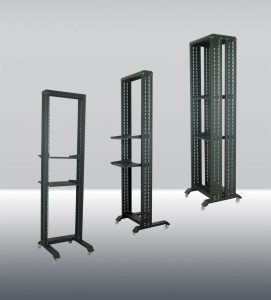
What is relay rack?
A relay rack is a type of rack that is specifically designed to hold electronic equipment, particularly telecommunications and networking equipment. Relay racks are typically used in data centers, server rooms, and other networking environments to organize and manage equipment.
Relay racks are typically 19 inches wide and come in a variety of heights, such as 42U or 23U, they are constructed of steel or aluminum and are designed to support heavy equipment. They have vertical mounting rails that align with the standard hole pattern of the equipment, which allows the devices to be easily mounted and removed. The equipment is typically mounted using brackets that are screwed into the rack, and the equipment can be slide in and out of the rack for maintenance and repair.
Relay racks are designed to support heavy equipment and to provide proper ventilation and cable management. They also have built-in grounding and bonding provisions to ensure proper grounding of the equipment and to protect against electromagnetic interference (EMI).
In summary, a relay rack is a type of rack that is specifically designed to hold electronic equipment, particularly telecommunications and networking equipment, it’s typically 19 inches wide, and come in a variety of heights, it’s constructed of steel or aluminum and are designed to support heavy equipment, they have vertical mounting rails that align with the standard hole pattern of the equipment, and they are designed to support heavy equipment, provide proper ventilation and cable management, and have built-in grounding and bonding provisions.
What does RU mean server rack?
RU stands for “rack unit” and it’s a measurement used to describe the height of equipment that is designed to be mounted in a server rack. One RU is equal to 1.75 inches (44.45mm) of vertical space. This measurement is used to determine how many rack units of space a piece of equipment will occupy in a server rack.
For example, a server that is 2U in height will occupy 3.5 inches (88.9mm) of vertical space in a server rack, because 2 x 1.75 inches = 3.5 inches.
When determining the size of a server rack, the rack’s height is measured in RU, as well as the height of the equipment that will be installed in the rack. This allows for proper planning of the rack space to ensure that all of the equipment can be installed and that there is enough room for cable management and future expansion.
It’s worth noting that the standard size for most server racks is 42U, which is 73.5 inches (1870mm) in height. But other sizes are also available like 19U, 20U, and 23U.
In summary, RU stands for “rack unit” and it’s a measurement used to describe the height of equipment that is designed to be mounted in a server rack, one RU is equal to 1.75 inches (44.45mm) of vertical space. The rack’s height and the height of the equipment that will be installed in the rack are measured in RU, this allows for proper planning of the rack space to ensure that all of the equipment can be installed and that there is enough room for cable management and future expansion.
What is network rack?
Known by many names, a network rack is a metal frame chassis that holds, stacks, organizes, secures and protects various computer network and server hardware devices. The term “network” refers to the rack being used to house network hardware like routers, switches, access points, and modems.
What is 19” Rack Shelve?
19” shelves are the ideal accessory for your server and network installations. Made of steel with a thickness of 1,2 mm. Surface finish: degreasing, etching, phosphating, powder coating. Protected against rust, oxidation, scratches and corrosion. Compliant with ANSI/EIA RS-310-D, DIN41491 PART1, IEC297-2, DIN41494 PART7, and GB/T3047.2-92 standards. Compatible with metric ETSI and 19-inch international standards. Fixing points at the sides of rear and front 19’’ mounting angles. Vented for air circulation. Adjustable depth. Made of steel sheet. Load carrying capacity is usually 50 kg for fixed shelves, 25 kg for sliding shelves.
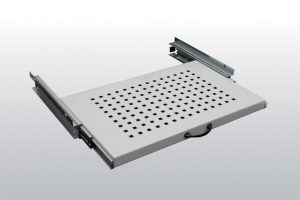
Color options are RAL 9005 Black & RAL 7035 White.
What is the standard rack size?
A standard server rack size is a “19 inch” wide rack enclosure with rack mount rails which are 17 3/4″ (ie 450.85 mm) apart and whose height is measured in 1.75″ (ie 44.45 mm) unit increments
What is the use of rack?
A rack, in an IT (information technology) context, is a supporting framework that holds hardware modules. In this context, racks typically contain servers, hard disk drives and other computing equipment or modems inside wall mount racks such as W-Line Rack Cabinet or SOHO Wall Mount Rack Cabinet . Racks make it possible to contain a lot of equipment in a small physical footprint without requiring shelving.
What are the international standards for 19” Rack Cabinets?
Some of main international standards are as below:
ISO 9001:2000 TSE:EN 61587-1 Mechanical Structures For Electronic Equipment – Tests For IEC 60917 And IEC 60297
- Climatic and Environment: EN 61587-1/4.2, IEC60068-2-1, IEC60068-2-2, IEC60068-2-30,
- Static Mechanical Load Lifting: EN61587-1/5.2.1
- Static Mechanical Load Stiffness: EN61587-1/5.2.2
- Dynamic Mechanical Load Vibration and Shock, Impact: EN61587-1/5.3.1,
- EN61587-1/5.3.3, IEC60068-2-6, IEC60068-2-27,
- Earth Bond: EN61587-1/6.2
- Flammability: EN61587-1/6.3
- Degrees Of Protection Provided By Enclosures (Ip Code): IP20 or IP55, EN61587-1/6.4
- Load Carrying Capacity: 600 kg
- Surface Treatment: Fosfat coating
- Corrosion Resistance: ISO9227 and ASTM B 117-85
- Painting: Ral7035 / Ral9005
Parts of a 19” Free Standing Rack cabinet
Door: Front door with glass door and perforated metal door option is available.
Cable Entry: On Top and bottom cable entry. Multiple cable entry points provide maximum versatility.
Mounting Rail: 4 pcs of 19″ adjustable mounting rails. Compatible with standard international 19 inch standard
Side Panels: Opening & lockable.
Painting: Impact-resistant, Electrostatic powder painting. Color options are RAL 9005 Black & RAL 7035 White.
Rear Panel: Can be removable and be mountable easily.
Main Height options: 12U, 15U, 16U, 19U, 20U, 25U, 27U, 30U 33U 35U 37U 39U 42U 45U
Main Width & Depth Options: 600x600mm 600x800mm 600x1000mm 800x800mm 800x1000mm
IP Rating Chart
IP66 = First Digit – Solids
IP66 = Second Digit – Liquids
Below is an easy to follow chart to help you decide which IP rating / IP Codes you may require for your Cabinet.
| IP Rating | First Digit – Solids | Second Digit – Liquids |
|---|---|---|
| IP54 | Protected from limited dust ingress | Protected from water spray from any direction, limited ingress protection |
| IP55 | Protected from limited dust ingress | Protected from low pressure water jets from any direction, limited ingress protection |
| IP56 | Protected from limited dust ingress | Protected from high pressure water jets from any direction, limited ingress protection |
| IP57 | Protected from limited dust ingress | Protected from immersion between 15 centimeters and 1 meter in depth, limited ingress protection |
| IP58 | Protected from limited dust ingress | Protected from long term immersion up to a specified pressure, limited ingress protection |
| IP60 | Protected from total dust ingress | Not protected from liquids, limited ingress protection |
| IP61 | Protected from total dust ingress | Protected from condensation, limited ingress protection |
| IP62 | Protected from total dust ingress | Protected from water spray less than 15 degrees from vertical, limited ingress protection |
| IP63 | Protected from total dust ingress | Protected from water spray less than 60 degrees from vertical, limited ingress protection |
| IP64 | Protected from total dust ingress | Protected from water spray from any direction, limited ingress protection |
| IP66 | Protected from total dust ingress | Protected from low pressure water jets from any direction, limited ingress protection |
| IP66 | Protected from total dust ingress | Protected from high pressure water jets from any direction, limited ingress protection |
| IP67 | Protected from total dust ingress | Protected from immersion between 15 centimeters and 1 meter in depth, limited ingress protection |
| IP68 | Protected from total dust ingress | Protected from long term immersion up to a specified pressure, limited ingress protection |
| IP69K | Protected from total dust ingress | Protected from steam-jet cleaning, limited ingress protection |
*The Cabinet provides IP66 protection against dust and water -without Fan, Filter and Air Exhaust/slot- integration performs IP66. Filter, Fan hauls and Air Slots may decrease the IP rating.
11 reasons why the future belongs to fiber optic
11 Reasons Why the Future Belongs to Fiber Optic “The future belongs to fiber optics!” This bold claim is backed by compelling reasons. Fiber optic technology is not just an upgrade—it’s a transformative infrastructure shaping how we connect, communicate, and consume information. Here are 11......
19″ Rack Cabinet
What is a 19” Free Standing Rack Cabinet? 19” free standing rack cabinets provide a robust, cost-effective enclosure solution. PDU mounting or connectivity on both the front and rear of the cabinet. The Free Standing 19” Rack cabinets are ideal for high-density data center environments,......
5 Fan Facts About the Fiber Optic Cables
Fiber optic cables are a type of cable that use glass or plastic fibers to transmit data. Here are some interesting facts about fiber optic cables: Speed: Fiber optic cables are capable of transmitting data at much faster speeds than traditional copper cables. This makes......
Advancements in Fiber Optic Technology: Improving Bandwidth and Transmission Rates
Fiber optic technology has revolutionized the way we communicate, providing faster and more reliable data transmission over long distances. The use of fiber optic cables has become increasingly popular in recent years, and the technology continues to evolve at a rapid pace. In this article,......
All about fiber optics
What does a fiber optic cable do? A fiber optic cable is a type of cable that uses glass or plastic threads to transmit data. These threads, or fibers, are extremely thin and are surrounded by a protective coating. They are able to transmit data......
Best Fiber Optic Cabling Installation Practices Guide
Fiber optic cabling installation is a complex process that requires specialized knowledge and equipment. Here are some best practices for fiber optic cabling installation to ensure a successful and reliable installation: Plan the Installation: Before starting the installation, it is important to plan......
Cable Blowing by Pressurized Air / Fiber Optic Cable Blowing Procedure
Cable Blowing (Sometime called air assisted cable blowing, Cable Blowing by Pressurized Air, air blowing, jetting and all these words are describing method of cable blowing with pressurized air) Cable Installation has been always a challenge for installers. There are several method to lay the......
Cable Blowing Lubricant
Cable blowing lubricants are specially formulated lubricants used to lubricate cables as they are being pulled through conduits or other tight spaces during the installation process. The lubricant is applied to the cables before they are pulled, and it helps to reduce friction and make......
Cable Blowing Machine work
Cable Blowing Machines here Click here to find out Cable Blowing Machine Product Portfolio Click Here Cable blowing machines, also known as a jetting machine or fiber optic cable blowing machine, is a device used to blow cables, such as fiber optic cables, into ducts......
Cable Spooling Machines: The Ultimate Guide to Efficient Cable Handling
In industries such as telecommunications, energy, manufacturing, and infrastructure, the need for Cable Spooling Machines have never been greater. Traditional manual spooling methods can lead to inconsistencies, labor-intensive processes, and increased cable damage. This is where cable spooling machines revolutionize operations by ensuring precise, automated, and......



